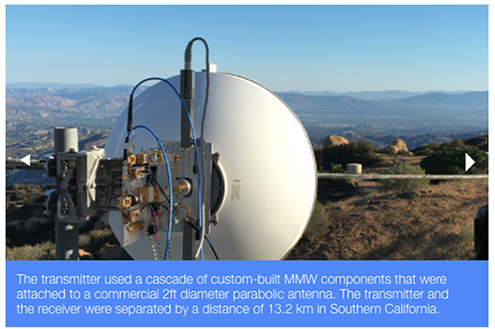Facebook Does 20 Gbps Millimeter-Wave Broadband

WOODLAND HILLS and MALIBU, CALIF.—The radio frequency folks at Facebook say they’ve achieved a data rate of 20 Gbps over millimeter-wave technology at a distance of more than eight miles. According to Abhishek Tiwari of Facebook Connectivity Labs, the RF team recently hit the 20 Gbps mark over 2 GHz of bandwidth using “custom-built components” and 105 watts of DC power total at the transmitter and receiver.
“To put this in perspective, our demonstrated capacity is enough data to stream almost 1,000 ultra-high-definition videos at the same time,” Tiwari wrote in a Facebook Engineering Blog entry posted Thursday.
MMW technology, designed for use in the extremely high frequency range of 30 to 300 GHz, is the next frontier of broadband and cellular networks. (See, “FCC Opens Higher Frequencies to Phone Companies,” July 14, 2016.) FB is experimenting with millimeter-wave technology “to provide connectivity in areas without traditional infrastructure and reliable power sources,” Tiwari said.
The 20 Gbps data rate was achieved over a millimeter-wave (MMW) link between the rooftop of FB’s lab in Woodland Hills to a Malibu mountaintop 8.2 line-of-sight miles (13.2 kilometers) away. Each location was equipped with E-band gear supporting data rates from 100 Mbps to 3 Gbps, depending on weather conditions.
System equipment included balanced mixers, frequency multipliers, isolators; custom-built amplifiers with “10 times the transmit power” of an E-band commercial-off-the-shelf amplifier, as well as custom-made polarizers, transducers and RF components said to “have more than twice the bandwidth of available off-the-shelf RF communications systems.”
In an effort to keep power consumption in check, the team developed “post-amplification spectrum multiplexing,” using many, smaller, more efficient amplifiers versus one large, low-efficiency version. A two-foot parabolic antenna was used at the transmit end and a four-footer was used at the receive site. The 3 dB beam width of the four-footer was around 0.2 degrees, requiring accuracy within 0.07 degrees to achieve 20 Gbps.
“This is equivalent to a baseball pitcher aiming for a strike zone smaller than the size of a quarter,” Tiwari said.
Calibration was done using the sun, yielding an algorithm that will support installations around the world. Conical scanning was further employed for high-precision aiming.
Ultimately, FB intends to use MMW links to connect a fleet of solar-powered drones designed to provide broadband coverage over a “60-mile-wide area on the ground,” at data rates up more than 30 Gbps.
The proposition requires overcoming significant technological challenges, Tiwari said. Among them, the inverse power-efficiency ratio of MMW amplifiers, the nonaerodynamic nature of parabolic antennas and atmospheric moisture.
“Specifically, rain and humidity could result in very high attenuation for terrestrial MMW links and could severely compromise their availability,” he said.
FB is currently flight-testing it first-generation air-to-ground 20 Gbps link on a Cessna flying at up to 20,000 feet. The next generation of FB’s MMW link will support 40 Gbps and is on deck for flight-testing in early 2017.
Also see…
Nov. 7, 2016
“Millimeter Waves Travel More Than 10 Kilometers in Rural Virginia 5G Experiment”
The team detected millimeter waves at distances up to 10.8 kilometers at 14 spots that were within line of sight of the transmitter, and recorded them up to 10.6 kilometers away at 17 places where their receiver was shielded behind a hill or leafy grove.
March 22, 2016
“Google Approved for Millimeter Wave Testing Across U.S.”
As of March 17, the FCC has granted permission to Google to perform airborne and terrestrial millimeter wave testing throughout the U.S.
Nov. 24, 2014
“Millimeter Wavelength Radios, Advanced Laser Technology Provide Gigabit/second Links”
A new technology developed by AOptix… combines a millimeter wave radio and infrared laser. The two devices are mounted on a tower or building in a box roughly the size of a coffee table and provide data rates up to 2 Gbps over distances up to 10 km, even in fog and rain.
Oct. 20, 2014
“Samsung Unveils Plans for 4.6 Gbps Wi-Fi”
Samsung says it has developed commercially viable 60 GHz millimeter-wave band Wi-Fi technology using the 802.11ad standard that enables data transmission speeds up to 4.6 Gbps.
Get the TV Tech Newsletter
The professional video industry's #1 source for news, trends and product and tech information. Sign up below.
